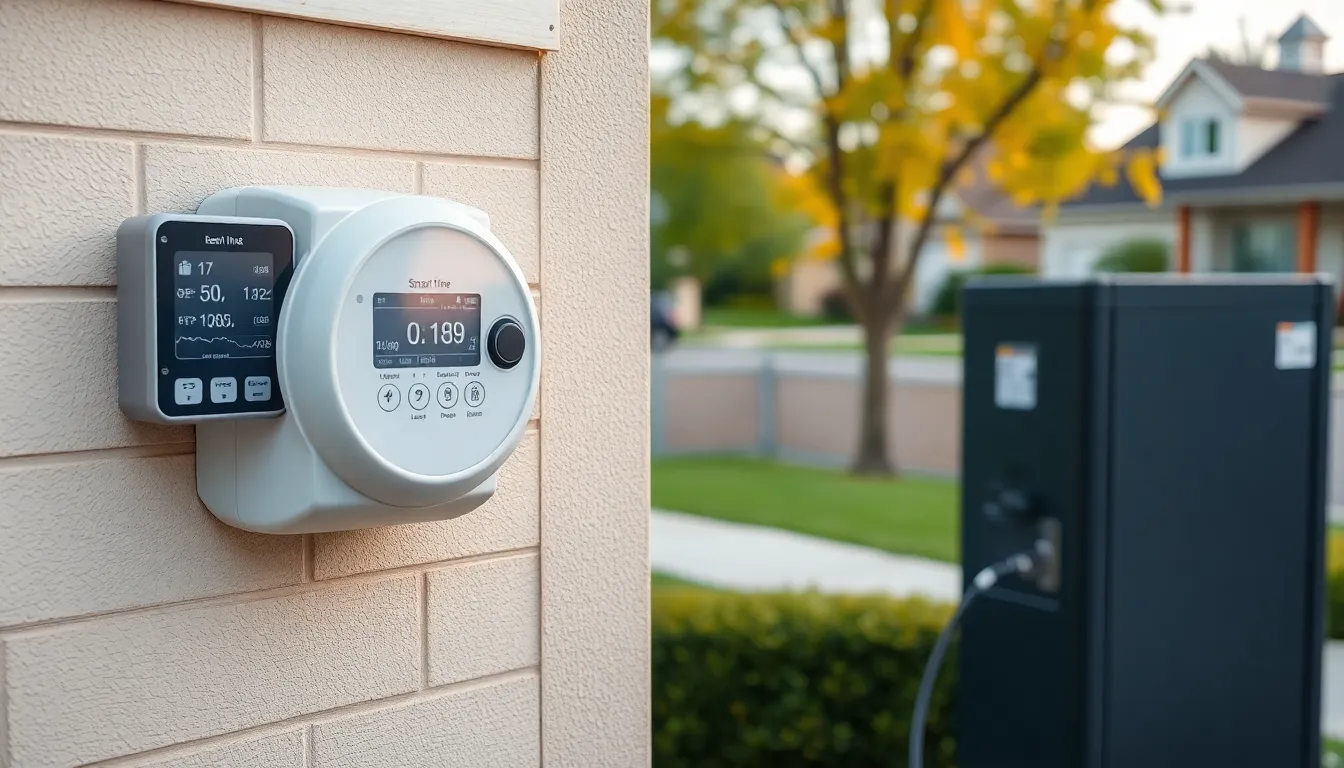Imagine a world where your toaster knows when to brown your bagel perfectly based on your morning mood. Welcome to the future of smart grids, where energy isn’t just smart—it’s practically a genius. As technology advances, the way we generate, distribute, and consume energy is evolving faster than a cat meme goes viral.
Table of Contents
ToggleOverview of Smart Grid Future
Smart grids represent a transformation in energy systems, integrating advanced technology with traditional infrastructure. Enhanced communication technologies and data analytics improve energy distribution and reliability. With real-time monitoring, utilities can identify and address issues before they escalate, ensuring a smoother energy flow.
Energy generation sources diversify in a smart grid future. Solar panels, wind turbines, and other renewable sources play a critical role in decreasing reliance on fossil fuels. Increased use of electric vehicles further contributes to energy demand, promoting a shift toward more sustainable practices.
Smart appliances actively interact with the grid, optimizing energy usage. Homeowners benefit from tools that adjust usage based on energy prices, maximizing savings. Utilities may offer incentives to encourage participation in demand response programs, allowing users to adjust consumption patterns during peak periods.
Cybersecurity becomes a priority as smart grids grow more sophisticated. Utilities invest in technologies to protect sensitive data and infrastructure against threats. Resilient systems support continued operations even during adverse conditions, enhancing consumer trust.
Collaborative initiatives among governments, utility companies, and tech firms foster smart grid development. Shared knowledge and resources stimulate innovation and investment. As more cities adopt smart grid technology, improvements in efficiency and reliability offer economic advantages, encouraging further advancements.
Legislation evolves to support smart grid initiatives. Policies that promote renewable energy sources facilitate integration into existing systems. Public awareness campaigns inform consumers about the benefits of smart grids, driving demand for innovative solutions.
Key Technologies Driving Smart Grid Development

Smart grids rely on various technologies to enhance energy efficiency and reliability. Key advancements facilitate seamless integration between the grid and users, promoting a sustainable future.
Advanced Metering Infrastructure
Advanced metering infrastructure (AMI) enables two-way communication between utilities and consumers. Smart meters, essential components of AMI, provide real-time data on energy usage, empowering customers to make informed decisions about consumption. Automated billing and remote monitoring enhance operational efficiency for utility companies while reducing costs. Data analytics gleaned from smart meters help identify consumption patterns, driving demand response initiatives that optimize energy usage during peak times. As more households adopt AMI, energy conservation becomes easier, creating a more resilient grid.
Energy Storage Solutions
Energy storage solutions play a crucial role in stabilizing the smart grid. Technologies like lithium-ion batteries store excess energy generated from renewable sources, ensuring availability during high demand periods. These solutions minimize reliance on fossil fuel power plants, advocating a cleaner energy mix. Innovative companies are developing advanced storage systems that enhance efficiency and reduce costs for consumers. Increased deployment of energy storage systems supports grid reliability, alleviates strain during peak hours, and enables effective load management across communities. As technology evolves, energy storage will become increasingly integral to smart grid infrastructure.
Benefits of a Smart Grid Future
Smart grids offer numerous advantages in energy management, boosting efficiency and reliability while integrating renewable resources.
Enhanced Reliability and Resilience
Enhanced reliability becomes evident with smart grids’ real-time monitoring capabilities. Utilities detect issues before they escalate, reducing outages significantly. Improved infrastructure adapts to changes in energy demand, ensuring stable delivery. Resilient systems withstand natural disasters better, maintaining service continuity even during emergencies. Data analytics allows for predictive maintenance, addressing potential failures proactively. By utilizing advanced technology, smart grids promote a more reliable energy landscape.
Improved Energy Efficiency
Improved energy efficiency results from smart grids’ ability to manage consumption dynamically. Smart meters provide users with real-time data on energy usage, enabling informed decisions about their consumption patterns. Energy-saving programs encourage participation by offering financial incentives during peak periods. Automated adjustments by smart appliances align energy usage with lower tariff times. Renewable energy sources, such as solar and wind, integrate seamlessly, enhancing overall system efficiency. Continuous feedback loops create an environment where both utilities and consumers optimize energy consumption collectively.
Challenges in Realizing the Smart Grid Future
Realizing the smart grid’s potential involves navigating several challenges. Key among these are cybersecurity risks and regulatory hurdles that impact its implementation.
Cybersecurity Risks
Cybersecurity remains a primary concern for smart grids. As utilities modernize their infrastructure, vulnerabilities may increase, making systems susceptible to attacks. Hackers could potentially compromise sensitive data and disrupt services, leading to severe consequences for consumers and utilities alike. Proactive measures, including robust encryption and continuous monitoring, are essential. Utility companies must invest in cybersecurity technologies to safeguard their networks and maintain consumer trust. Collaborative efforts with cybersecurity experts can further strengthen defense mechanisms against potential threats.
Regulatory and Policy Hurdles
Regulatory challenges significantly affect smart grid development. Existing policies may not align with the innovative technologies that smart grids incorporate. Governments must adapt regulations to facilitate advancements in energy management and renewable energy integration. Clear guidelines promote collaboration among stakeholders, ensuring that investments flow into smart grid initiatives. Engaging stakeholders in policy discussions can enhance outcomes, providing clarity on roles and responsibilities. Flexibility in regulatory frameworks supports innovation, allowing utilities to implement advanced solutions that enhance grid resilience and efficiency.
Global Trends in Smart Grid Implementation
Increasingly, countries are adopting smart grid technologies to enhance energy efficiency and reliability. Investments in smart grid infrastructure show a rapid rise, with global spending expected to reach $100 billion by 2025 according to industry forecasts. This trend reflects a growing commitment to integrating renewable energy sources and improving grid resilience.
Fostering collaboration between governments, utilities, and tech companies drives this change. Partnerships facilitate innovation and financial backing for large-scale smart grid projects. Several nations, including the United States and Germany, lead efforts to implement smart grid solutions through substantial federal and state funding.
Regulatory frameworks also evolve to support smart grid initiatives. Policies are designed to encourage renewable energy adoption and incentivize utility companies to invest in advanced technologies. In the European Union, legislation promotes energy efficiency and enhances public awareness about smart grid benefits.
Emerging technologies significantly shape smart grid implementation. Advanced Metering Infrastructure (AMI) plays a crucial role by enabling two-way communication between utilities and consumers. Smart meters provide real-time usage data, which informs demand response programs and allows customers to adjust their consumption based on current energy prices.
Simultaneously, energy storage solutions, particularly lithium-ion batteries, are gaining popularity. These systems store excess renewable energy, stabilizing the grid during peak demand. Such storage options reduce reliance on fossil fuels while enhancing overall system efficiency.
Addressing cybersecurity risks ranks high on the agenda for smart grid development. Enhanced monitoring and robust encryption measures are increasingly important as infrastructure modernizes. Consumer trust hinges on the ability of utilities to protect sensitive data from potential threats.
Efforts to harmonize standards across regions promote seamless energy trade and improved grid resilience. As more cities worldwide deploy smart grid technology, tangible improvements will manifest in efficiency and sustainability.
The smart grid future presents an exciting opportunity for transforming energy systems globally. By merging advanced technology with traditional infrastructure, it paves the way for a more efficient and sustainable energy landscape. As smart appliances and renewable energy sources become commonplace, consumers will enjoy greater control over their energy usage and costs.
Challenges like cybersecurity and regulatory hurdles must be addressed to fully realize this potential. However, ongoing collaboration among governments, utility companies, and technology firms will drive innovation and investment. As smart grids evolve, they promise not only to enhance reliability and efficiency but also to contribute significantly to economic growth and environmental sustainability. The journey toward a smarter energy future is underway, and its impact will be profound.









